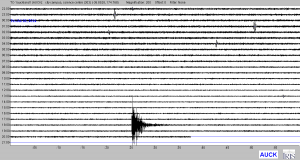More often than not, the screen of your seismic stations may look something like this:
Overall, the wiggles are small. The few spikes in this case are probably due to some electronic interference in the area where station AUCK is housed.
BUT: If you see something on your seismometer screen that stands out from the rest of your recordings, like this:
Then, there are a number of things you can check to see if you recorded an earthquake (or if this was some noise generated by bumping into the sensor, for example).
Geonet
Geonet is “the official source of geological hazard information for New Zealand,” according to the site. They run a large network of seismometers in New Zealand, whose data is the source of information about all recorded earthquakes in New Zealand. Can you find an earthquake that would arrive at your school at the time of your signal?
USGS
The United States Geological Survey runs a world-wide version of Geonet. Its list of recent earthquakes can be found here.
If you want to get updates via email, text message or twitter, you can sign up for alerts from Geonet and from the USGS.
Your sister institutions
You can also directly compare the wiggles on your screen with either the wiggles from the other schools in the network, or with the closest “live” signals that geonet provides. In this last link is a map on the right where you can find the station that is closest to your school.

